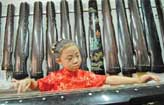China-US
Digging out of the foreign exchange reserves
Updated: 2011-08-02 10:48
By Zhang Yi (China Daily)
BEIJING - By the end of June, China's foreign exchange reserves reached $3.2 trillion, almost three times that of Japan, which is the world's second-largest holder of foreign exchange reserves. How to make good use of the large pool of foreign currency has always been the focus of the Chinese government.
Over the years, asset security has been the authorities' top priority in using foreign exchange reserves. Therefore, a large part of the reserves have been invested into United States Treasury bonds and US government-backed corporate bonds, widely regarded as most secure.
An example is the purchase of the Fannie Mae and Freddie Mac bonds, the two largest mortgage finance lenders in the US that are financially protected by the the US government. But the value of these bonds took a nosedive amid the financial crisis.
More than that, the recent debate on whether Congress would raise the national debt limit indicates investments that were considered absolutely safe faced the risk of default.
Since most of China's foreign exchange reserves are in dollar assets, the country inevitably suffers the risk of assets shrinking when the dollar depreciates.
In light of this, there are heated discussions of diversifying the reserves. But there are two obstacles that cannot be overlooked.
First, it is hard to find a new investment channel better than the dollar or US Treasury bonds against the backdrop of the current economic climate.
No matter euro or yen, their liquidity and status in the international monetary system cannot challenge the dollar. Moreover, economic fundamentals of the two economies are even worse than the US, and theoretically speaking, their currencies are in fact facing the pressure of devaluation against the dollar.
As for bond yields, because of a long-term low interest rate policy adopted in Japan, the yen bond yield cannot compete with US bonds.
Second, under the current management model, the reserve diversification cannot resolve the inflationary pressure that resulted from the significant increase of funds outstanding for foreign exchanges, the money issued by the central bank to buy the foreign exchange.
In the short term, moderately diminishing the excessive proportion of dollar assets in China's foreign exchange reserves would help reduce the risks of placing all of China's eggs in one basket as well as relieving the pressure of China's economy being hijacked by the US.
But the Chinese government cannot change the reality that the dollar and dollar assets occupy a predominant proportion of China's foreign exchange reserves.
The disposal of China's foreign exchange reserves should meet two goals in the long run.
The first is to reduce implicit or explicit costs caused by the too fast of an increase of foreign exchange reserves, which includes the inflationary pressure as a result of the surge in funds outstanding for foreign exchanges and the interest costs from the issuance of new central bank bills to offset the adverse economic effects.
The second goal is to maintain or increase the value of foreign exchange reserves to cope with the demand for surplus savings from an aging population and the demand for foreign exchanges from foreign capital outflows in the future. As it is difficult to reverse the "double surplus" situation (current account surplus and capital account surplus) in the short term, our present primary task is to find a proper way to handle the new foreign exchange inflow.
We can follow the common practice of an open economy and let the Ministry of Finance issue treasury bonds or purchase foreign exchange with the budget surplus. Although such an approach would bring some financial pressure in the short term, it would ward off more negative effects resulting from a more bloated balance sheet of the central bank and improve the independence of the monetary policy as well as restraining the occurrence of an unrestricted expansion of foreign exchange reserves in some government departments. Although these are not foreign exchange assets held by monetary authorities, they are owned by other government agencies and are part of the foreign exchange reserves.
As soon as the government departments get the foreign exchanges, their first consideration is to maintain and increase the value of the money.
Because of the lack of mature overseas investment projects, the scale of China's overseas investment is not big enough to absorb massive foreign exchange reserves in the short term. Therefore, to invest overseas is not realistic.
But we can refer to the "Angola mode" (a resource-for-infrastructure investment mechanism) by offering loans to developing countries that are thirsty for funds for large-scale infrastructure construction.
In order to ensure security and China's future growth needs, the borrowing countries should provide the lender with tangible assets as collateral. The agreement can even specify that when the loan expires, the lender could buy the assets at a pre-agreed price.
The author is a researcher with the Institute of Foreign Economy, the National Development and Reform Commission.
For China Daily
(China Daily 08/02/2011 page2)

Specials

Carrier set for maiden voyage
China is refitting an obsolete aircraft carrier bought from Ukraine for research and training purposes.
 Photo
Photo  Video
Video

Pulling heart strings
The 5,000-year-old guqin holds a special place for both european and Chinese music lovers

Fit to a tea
Sixth-generation member of tea family brews up new ideas to modernize a time-honored business